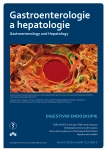A tumorous atrioesophageal fistula as an unusual cause of septicemia
Authors:
T. Fislová 1; R. Keil 1; J. Masopust 1; M. Grega 2
Authors place of work:
Interní klinika 2. LF UK a FN Motol, Praha 2 Ústav patologie a molekulární medicíny
2. LF UK a FN Motol, Praha
1
Published in the journal:
Gastroent Hepatol 2018; 72(3): 260-263
Category:
Gastrointestinální onkologie: kazuistika
doi:
https://doi.org/10.14735/amgh2018csgh.info06
Summary
A 70-year-old male admitted to an emergency ward was examined for signs of sepsis. He complained of suffering from epigastralgia, food stagnation sensations, absence of appetite, and severe weight loss for several months. Elevation of inflammatory markers, dehydration, an ion imbalance, and microcytic anemia were found. The cause of sepsis was not revealed by abdominal ultrasonography, abdominal and chest X-rays, and abdominal, thoracic, and pelvic computer tomography. Transesophageal echocardiography was planned to rule out infectious endocarditis; however, gastroscopy was performed as a first-line examination. Blood was observed in the distal esophagus and stomach throughout this procedure. Refractory shock occurred during the examination, followed by unsuccessful cardiopulmonary resuscitation. Esophageal adenocarcinoma with an atrioesophageal fistula was found on autopsy, which was the cause of endocarditis and septic emboli in the systemic circulation. Installation of the nasogastric probe and air insufflation at the beginning of the gastroscopic examination likely caused the release of masses that originally filled the fistula, leading to massive bleeding and refractory hemorrhagic shock.
Key words:
esophageal neoplasms – fistula – sepsis
The authors declare they have no potential conflicts of interest concerning drugs, products, or services used in the study.
The Editorial Board declares that the manuscript met the ICMJE „uniform requirements“ for biomedical papers.
Submitted: 8. 2. 2018
Accepted: 5. 3. 2018
Zdroje
1. Magnusková S, Kollárova H, Kamarád V et al. Dvojí tvář rakoviny jícnu – epidemiologie a etiologie. Gastroent Hepatol 2011; 65 (5): 255–263.
2. Shah S, Saum K, Greenwald BD et al. Esophagopericardial fistula arising from Barrett‘s esophagus. Am J Gastroenterol 1998; 93 (3): 465–467.
3. Ali F, Mostafa A, Charachon A et al. Multidisciplinary therapy of a large esophago-pericardial fistula arising from Barrett‘s esophagus. Ann Thorac Surg 2008; 86 (5): 1690–1693. doi: 10.1016/j.athoracsur.2008.03.023.
Štítky
Detská gastroenterológia Gastroenterológia a hepatológia Chirurgia všeobecnáČlánok vyšiel v časopise
Gastroenterologie a hepatologie

2018 Číslo 3
- Metamizol jako analgetikum první volby: kdy, pro koho, jak a proč?
- Fixní kombinace paracetamol/kodein nabízí synergické analgetické účinky
- Antidepresivní efekt kombinovaného analgetika tramadolu s paracetamolem
- Kombinace paracetamolu s kodeinem snižuje pooperační bolest i potřebu záchranné medikace
- Parazitičtí červi v terapii Crohnovy choroby a dalších zánětlivých autoimunitních onemocnění
Najčítanejšie v tomto čísle
- Vistaprep – standard přípravy střeva před koloskopickým vyšetřením
- Tumorózní atrioezofageální píštěl jako neobvyklý zdroj sepse
- Intoxikácia Amanita phalloides – stále aktuálny problém?
- Naše zkušenosti s léčbou masivního krvácení u Crohnovy nemoci pomocí anti-TNF terapie
